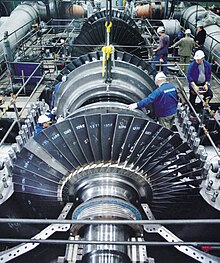Turbo machine

A flow machine or turbo machine is a fluid energy machine in which the energy transfer between fluid and machine in an open space takes place through a flow according to the laws of fluid dynamics via the detour of kinetic energy .
Functionality and delimitation
The energy is usually transmitted by means of rotor blades , vanes or blades that are profiled in such a way that the flow around them creates a pressure difference between the front and rear ( wing profile ).
The counterpart to the turbomachine is the displacement machine (also known as the piston machine ), in which the energy transfer takes place in a closed space (with valves or similar) with a variable volume according to the laws of fluid statics .
The areas of application of fluid flow and displacement machines differ mainly in that the advantages of the fluid flow machines usually outweigh the advantages of the fluid flow machines with large volume flows and those of the positive displacement machines with small ones.
The effect of flow machines is linked to the flow rate of the fluid; if the machine runs too slowly, there is no more energy transfer and since the fluid is not trapped, it escapes from the machine. In an ideal displacement machine (see below), however, the fluid is firmly enclosed; it cannot escape and the transfer of energy can theoretically take place infinitely slowly without reducing the effectiveness of the machine.
A definition criterion for fluid flow machines that is often wrongly mentioned is a rotating movement or a stationary, non-clocked process. But this is not always the case; There are also rotating and continuously working displacement machines ( rotary piston machines such as Roots blowers, etc.) and there are also translationally oscillating flow machines ( lifting wing machines , fan machines , etc. - derived from wings and fins from the animal world).
A special form of fluid flow machines are those that do not require a housing to control the fluid, such as the propellers of household fans, aircraft drives or ship propellers, the rotors of wind turbines or agitators .
Classification of the fluid flow machines into types and groups
Fluid flow machines are divided into the following types and groups according to the type of fluid, the direction of energy flow and construction:
| Machine type → group ↓ |
Working machines | Combinations of power and working machines |
Power machines |
| Caseless flow machines | propeller | Grim's idler | Wind turbine |
| Hydraulic flow machines (≈ incompressible media) |
Centrifugal pumps |
Föttinger converters and clutches (hydrodynamic gears) or pump turbines (in pumped storage plants) |
Water turbines |
| Fans | |||
| Thermal flow machines (compressible media) |
compressor |
(Gas turbines) (entrance of the GT consists of a compressor) |
Steam turbines ← Gas turbines Turbine jet engines |
Note: Colloquially as a fan called electrical appliances are in the table above as a propeller to find because it except a grid (to prevent injury) no case have. Floor or tower fans, however, are centrifugal fans with a housing and can therefore also be found in the table as fans .
Dimensionless key figures for the description of turbomachines
The following dimensionless parameters are often used to characterize fluid flow machines.
- Pressure number ψ
- Flow rate φ (also called delivery or volume number)
- Diameter number δ
- Running number σ
- Coefficient of performance λ
- Specific speed n s or n q
These similarity indicators allow the comparison of turbomachines of different dimensions with different boundary conditions and play a role in the design of the machines. An example of its application is the Cordier diagram .
literature
- Carl Pfleiderer , Hartwig Petermann: Turbo machines (= technology classics ). 7th edition. Springer, 2004, ISBN 3-540-22173-5 ( limited preview in Google book search).
- Klaus Menny: Turbomachinery . 5th edition. Vieweg + Teubner, 2006, ISBN 3-519-46317-2 ( limited preview in Google book search).
- Wolfgang Kalide: Pistons and flow machines . 1st edition. Carl Hanser Verlag, Munich / Vienna 1974, ISBN 3-446-11752-0 .
- Herbert Sigloch: Fluid machines: Fundamentals and applications . 3. Edition. Hanser-Verlag, 2006, ISBN 3-446-40288-8 .
- Willi Bohl: Turbomachinery . Kamprath series. Ed .: Wolfgang Elmendorf. tape 1 : Structure and mode of operation. tape 2 : Calculation and calculation. , No. 9 . Vogel reference book, 2004, ISBN 3-8023-1980-X .
Web links
Individual evidence
- ^ A b c Carl Pfleiderer, Hartwig Petermann: Turbo machines. 2004, p. 1.
- ↑ a b Klaus Menny: Turbo machines . 2006, p. 1.
- ↑ a b C. Brücker, R. Schwarze: Fluid energy machines . Based on the lecture notes by G. Gneipel. Institute for Mechanics and Fluid Dynamics, TU Bergakademie Freiberg, Freiberg 2007 ( full text on tu-freiberg.de [PDF]).
- ↑ Frank Kameier: Turbomachinery . Lecture notes. Institute for Fluid Flow Machines , Düsseldorf University of Applied Sciences, Düsseldorf 1999 ( full text (PDF; 9.4 MB) on ifs.fh-duesseldorf.de).